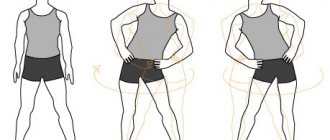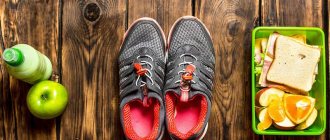Warm-up before starting a workout is a set of exercises that prepares the body for intense physical activity. With its help, you will halve the risk of sports injuries and increase the benefits of exercise. Duration – 5-15 minutes.
Warm-up can be general or specific. General – aerobic exercise. Its goal is to saturate the muscles with oxygen. With the help of a general aerobic warm-up, they increase muscle tone, warm up tendons and ligaments, speed up the heart rate, and slightly increase blood pressure. General warm-up options include jogging, jumping rope, cycling or an exercise bike.
Strength anaerobic warm-up prepares a specific group of muscles and joints for exercise with heavy sports equipment. It helps to feel the work of the muscles, improves its blood supply, and provides mild preliminary fatigue.
Content
- Benefits of warming up: Warming up the joint-ligamentous apparatus
- Warming up the muscles
- Cardiovascular preparation
- Smooth increase in body temperature
- Mental preparation
- Joint gymnastics
Proper three-step warm-up
How to do a warm-up, properly warm up your muscles and not get tired before the main workout begins? Let's take it in order.
Types of warm-ups
We can put it another way and replace “types” with stages. Because first, a general warm-up is done, and then, as the workout progresses, a warm-up is done for all muscle groups that will be loaded.
A general warm-up includes cardio and joint exercise. And warming up for specific muscle groups means working without weights or with light weights before specific exercises.
Let us now clarify how to warm up correctly and what set of exercises can be used for warming up.
Cardio - the first stage
A proper pre-workout warm-up begins with cardio.
You need to devote 5 to 20 minutes to running, an exercise bike, or an elliptical machine. You can combine exercise machines with jumping rope or other high-intensity cardio exercises.
- Fitness warm-up before weight training should be minimally energy-intensive. That is, the intense cardio part should be completed in 5–7 minutes.
- But if your goal is to lose weight, you need to run or jump longer - at least 20 minutes.
So, your pulse has risen, blood circulation has activated, the blood quickly carries oxygen and other necessary substances throughout the body.
Next, the question arises of how to warm up the muscles and joints to reduce the likelihood of injury. Let's look at the basic exercises for warming up before training.
Joints - second stage
Circular movements with different parts of the body help warm up your joints before training:
- Gently rotate your head. First, make 10 circular movements clockwise, then the same number counterclockwise. With each movement, try to increase the diameter of the circle being described.
- Pull your chin towards your chest, tilt your head as far as possible to the right and left. Repeat this movement several times.
- Place your fingers on your shoulder joints and roll your shoulders. Do these rotational movements with your arms in both directions 10 times each. Circular movements are made simultaneously with both arms bent at the elbows.
- Now you need to describe the circle several times with one and the other hand, turning your arm at the elbow.
- Then we do the same, rotating the hands at the wrists. Clench and unclench your fingers several times.
- Next, we make circular movements with the upper part of the body while standing on our feet.
- We fix the body and make circular movements with our hips, placing our hands on the belt.
- Now you can swing your legs forward and backward 10 times or squat 10 times at a pace.
- Raise your knee so that your thigh is parallel to the floor, and point your toes down. You need to draw a circle with your toe above the floor using movement in the knee joint.
- Place your toe on the floor and make rotational movements with your ankle.
Thus, we worked through all the joints sequentially from top to bottom.
There are other exercises to warm up your joints before exercise. They are done in exactly the same way, but your task will be to draw the number 8 instead of a circle. This warm-up is used in various schools of hand-to-hand combat. The effectiveness of this warm-up scheme lies in the fact that such a trajectory of movement warms up the joint much better than just a circular one.
Indeed, if you analyze this diagram, then in one exercise you perform several simple movements at once. For example, when tracing the number 8 with your head, you move your head forward, backward, right, and left. There are also circular trajectories.
How to conduct such a warm-up is exactly the same as a regular circular one. This is a very interesting way to prepare the body for training.
Warm-up at home is carried out in the same two ways: in a circle and in the figure 8.
Warm-up before training can take place in the form of outdoor active games, if we are talking about a children's sports section.
In martial arts schools, they conduct a warm-up to strengthen the body's strength and coordination resources. Such preparation allows you to warm up your muscles before training and prepare your body for good coordination.
How to make training safe? Do a basic warm-up!
The benefits of warming up
Warming up the articular-ligamentous apparatus
Against the background of the average daily activity of a metropolis resident, the ligaments lose their elasticity. If they are not pre-warmed, the risk of sprains and tears during exercise increases.
Warming up before exercise increases the production of synovial fluid, which acts as an intra-articular lubricant, which increases joint mobility. Without it, the risk of arthrosis and arthritis increases in the medium term.
Warming up the muscles
“Cold” muscles are susceptible to spasms and cramps, sprains, tears and tears. On the contrary, warmed muscles contract and relax better, so the athlete’s strength capabilities increase.
Saturating your muscles with oxygen and nutrients also increases endurance during exercise. In addition, to form an attractive body shape and gain muscle mass, neuromuscular connections are needed, which are triggered during warm-up.
Cardiovascular preparation
At rest, the heart rate of an adult is 60-80 beats per minute. During physical activity it increases to 140-170. Without warming up, your internal “engine” figuratively switches from 1st automatic gear directly to 5th. Because of this, hypertrophy of the heart muscle gradually develops - “sports heart” syndrome.
It is often accompanied by functional cardiac disorders - irregular heart rhythm, rapid pulse, increased blood pressure. In order not to provoke the listed conditions, the heart rate should increase gradually - during the warm-up before training.
Smooth increase in body temperature
Normally, during physical activity, body temperature rises. Warming up triggers the natural process of thermoregulation, so your well-being does not deteriorate during the workout. Experts recommend training until light sweat appears on the forehead - this is a sign that the body is ready for more intense exercise.
Mental preparation
Psychology is an important component of the training and competitive process. Understanding that you are doing everything correctly, controlling muscle load, working according to plan, mentally sets you up for maximum results. At the same time, motivation increases, and training becomes more productive.
In addition, during warm-up, the synthesis of hormones responsible for energy production is activated, coordination of movements and attention are increased.
Why is it dangerous not to warm up before an intense workout?
Exercising without warming up increases the risk of sprains, muscle strains, or joint injuries. They are followed by breaks in classes, that is, a stop in sports progress and a rollback of existing results. If you do not systematically warm up, this harms the heart muscle (in some cases, sudden surges in pressure and even fainting are possible).
In addition, the unpreparedness of the body's systems for intense training loads produces rapid fatigue and loss of enthusiasm during exercise. Ignoring the warm-up is a typical mistake of beginners who do not want to waste time and, as a result, often get injured in their first classes.
Warm-up plan before working out in the gym
Joint gymnastics
Rotational movements, turns and/or bends in each direction, starting from the neck and ending with the ankle joint. When stretching your neck, avoid rotation, as this part of the spine is extremely vulnerable and any axial loads are potentially dangerous.
Tilt your head to the sides, forward, and gently back (the chin reaches toward the ceiling). After this, carefully knead the rotator cuff of the shoulder joint - to do this, swing in different planes - to the sides, back, up.
Then perform rotational movements in one direction and the other in:
- shoulder joints;
- elbows;
- brushes;
- lumbar spine (if axial loads are contraindicated, replace rotations with tilts);
- hip joints;
- knee;
- ankle.
Do 10-15 repetitions at an average pace. The time for performing joint warm-up before training is 2-3 minutes.
Stretching
Dynamic stretching exercises for all muscle groups mobilize muscle tissue, stretch fascia, stimulate the flow of oxygen to muscle cells, and prepare muscles for power load. The complex is carried out on a top-down basis. Pay special attention to large muscle groups - pectoral muscles, latissimus dorsi, spinal extensors, hip adductors and hamstrings. At the points of maximum tension, it is enough to linger for 5-10 seconds.
Hanging on a bar is suitable for stretching all muscles. To stretch your pectoral muscles, place one hand on a squat rack and lean your whole body forward or spread your arms out to the sides and back as far as possible. To stretch your lower back and hamstrings, do a straight-legged forward bend or hyperextension. Lunges are suitable for stretching the leg muscles.
When performing stretching exercises, you should feel muscle tension, but not pain or discomfort. The complex execution time is 2-3 minutes.
Cardio
Cardio warm-up prepares the cardiovascular system for physical activity. Perform light aerobic exercise with a heart rate of 130 beats per minute. This speeds up metabolism and triggers the processes of lipolysis - the oxidation of adipose tissue.
Cardio warm-up options include walking on a treadmill, elliptical or stepper, walking with high knees, arms and legs. The duration of the complex is up to 5 minutes. Finish when you feel that your body temperature has increased slightly.
Life hack: start your cardio warm-up wearing relatively warm sportswear, such as a sweatshirt, and when you warm up, take it off.
Strength warm-up
For the strength phase of the warm-up, experts recommend CrossFit exercises with minimal weights - no more than 20-30% of the workload. Pay special attention to the muscle group you are training today.
For example, on shoulder day do straight arm swings with ~4 kg dumbbells, on arm day do curls with dumbbells, on chest day do wall push-ups, on leg day do 3 sets of squats. You can perform exercises from the main workout, but in a simplified technique. When performing a strength warm-up, it is important to isolate each muscle group and load it specifically. Therefore, choose isolated exercises, and not, for example, deadlifts.
Options for strength exercises to warm up before training (do it selectively):
- Neck – bend the neck while lying down with a disc on the back of the head or on the forehead. 2 sets of 20 reps.
- Shoulders – standing, swinging dumbbells to the sides or in front of you//barbell row with a wide grip to the chin. 2 sets of 25 reps.
- Chest – push-ups//crossover crossover. 3 sets of 20 reps.
- Back – hyperextension//upper side row with wide grip//pull-ups with wide grip. 2 sets of 15 reps.
- Arms – lifting from the lower block with an EZ-handle to the biceps//extension of the arms from the upper block with a rope handle. 3 sets of 20 reps.
- Press crunches while sitting in a machine. 2 sets of 25 reps.
- Legs – squats with your own weight // leg abduction, sitting in a machine // leg curls, sitting in a machine // leg extensions, sitting in a machine. 3 sets of 20 reps.
The duration of the strength warm-up complex is no more than 5 minutes.
10 effective exercises for cracking and crunching knees
Stretching while standing
Stand up straight. Feet hip-width apart. Grab your right it back. Using your hand, gently pull your leg toward your gluteal muscles . You should feel a stretch in the anterior and posterior thigh muscles . Stay in this position for 30 seconds and repeat the exercise with the other leg . If you have difficulty maintaining your balance in this position, lean against a chair or wall. Perform 5 sets for 30 seconds with each leg . [4]
Massage the thigh muscles with a roller
You will need a fitness roller for this exercise. Lie on your stomach and place a bolster under your right leg just above the knee. Pull in your abdominal muscles and roll the roller between your hip bones and kneecaps . Then change legs. You should perform smooth movements with moderate intensity. The fitness roller will massage the front of the thigh well . Start with one set of 5 repetitions on each leg . The goal of this exercise is to relax the quadriceps muscle , which often puts stress on the knees, leading to popping . [7]
3. Standing leg circles
Stand up and lean against a wall or chair with one hand so you can focus on proper technique. Keep your back straight. Raise your right leg so that your knees are bent at a 90-degree angle. Begin to move your hip to the side, drawing a large circle with your knee. Do one series of 10 repetitions on each leg. Focus on movements that will help relax and stretch your thigh muscles. This exercise results in improved knee movement and reduced tension.[7]
Static Lunge
Let's start standing. Take a small step forward with your right foot, and then take a half step back with your left foot. Slowly straighten your front leg by slightly bending your knee. In this case, you should stand on the toe of a slightly bent back leg. Pull your stomach in and push your hips up. Stay in this position for 20 seconds and then switch legs . Repeat 5 times for 20 seconds with your right and left legs. The purpose of this exercise is to reduce tension in the knees by stretching the thigh muscles . [7]
Straight leg swing
Take a standing starting position. For better stability, you can lean against a wall or chair. Stand on your left leg, lift your right leg forward to a horizontal position and smoothly lower your leg down, and then move your leg back. This is how you should swing your leg forward and backward . Raise your leg as high as you can . Repeat 5 times on each leg . The purpose of this exercise is to stretch the front and back of the hip joint to relieve tension in the knees. [7]
Deadlift
This exercise can be done with or without weights, depending on your fitness level. Start in an upright position with your feet hip-width apart. Bend your knees and pull your upper body forward. Keep your back straight, neck should be elongated. After completing the exercise, return to the starting position. You will feel the muscles in your back, hips and lower back . Also, when performing the exercise, the pelvis works. The goal of this exercise is to strengthen your hips to reduce stress on your knees. [7]
Stretching the iliotibial tract
The Iliotibial band is located on the outer part of the thigh , from the thigh all the way to the lower leg. This ligament is also connected to the knee and helps stabilize and flex the joint. Its contraction or inflammation can cause the patella to become dislodged , resulting in knee pain that is usually felt on the outside of the knee. The main causes of this problem are grueling training or sudden stress during running , to which the body has not yet had time to adapt. This exercise will help relieve tension.
Lie sideways on a fitness mat. Take a fitness roller and rest your thigh on it. Cross your legs, placing the foot of your right bent leg in front of your left knee. Roll the side of the thigh from the wing of the ilium down, stopping just above the knee, and in the opposite direction. Repeat at 30-second intervals for 2 minutes . Next, take the opposite position to roll the other leg. [5]
Squats for the inner thigh
The inner thigh is a problem area because it is usually weaker than the outer thigh. To strengthen your muscles and relieve knee pain, we recommend squats to strengthen your inner thigh muscles.
Stand shoulder-width apart with your feet turned outward (45-degree angle), keeping your weight on your heels. Start in a half squat and then squat onto an invisible chair that is far behind you. When squatting, bend your knees and try to go as low as possible , but no more than 90 degrees. Then lift up without lifting your heels. Perform 3 sets of 15 repetitions. [5]
Exercise to develop the vastus medialis muscle
The vastus medialis is a muscle that is located near and inside the kneecap. usually the weakest muscles in the thigh. These muscles can be weak and tight in both most people and athletes. Hundreds of people suffer from torn knee ligaments every year, often due to weak hip muscles. [5]
Do the exercise as follows. Stand with one foot in front and transfer your weight to your leg. Squat down and stop in a half squat . Your front knee should remain directly above your ankle. As you squat, gently rotate your front leg to the right and hold it in this position for 5 seconds. Relax your leg and stand so that you rest and transfer the load to your toes. Do 3 sets of 15 repetitions on each leg.
Unloading the calf muscles
The calf muscle release technique will help reduce muscle tension and compression from pressure. Stretching helps stretch the muscles, and relaxation allows the contracted muscles to activate . This technique will help relax your contracted calf muscles.
Sit on a fitness mat. Bend one leg at the knee and extend the other. Place a fitness roller or tennis ball under the outstretched leg . Roll your foot back and forth over the ball or roller. Once you find a sensitive spot, stop and roll the roller in that spot. Massage the ukra for at least 30 seconds and then switch legs. [5]
Warm up before training at home
You can exclude cardio exercises from warming up before training at home, since home exercises are not as intense as in the gym and increase the heart rate slightly. If desired, the treadmill can be replaced by running in place or “shadow boxing” - an imitation of boxing sparring with an imaginary opponent.
Cardio warm-up can be replaced with exercises for the whole body, such as jumpingjack - jumping while clapping overhead, or squats and throwing a ball at the wall. If home workout time is limited, joint exercises and stretching are sufficient.
Positive effects when doing joint gymnastics
Joint gymnastics has the following advantages:
- ridding the body of salt deposits;
- strengthening the muscles of the whole body;
- weight loss;
- increasing flexibility and endurance of the body;
- positive effect on the state of the nervous system;
- rejuvenation;
- getting the necessary physical activity;
- normalization of the thyroid gland.
Exercise lifts your spirits and energizes you throughout the day.
Interested in trying out a gym workout using HUR machines? Sign up for any starter course!











